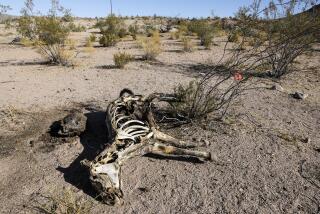Judge Halts Killing of Bison in Yellowstone After Rangers Shoot 3 : Ecology: Park rangers destroyed animals as part of a study of an infectious disease. Animal protection group wins order against 22 others being shot.
- Share via
Park rangers killed three bison Monday in Yellowstone National Park, but a federal judge in Washington stepped in and halted the shooting of others.
The National Park Service had announced plans to kill 25 of the shaggy animals--which are the agency’s mascot and the symbol that appears on the shoulder patches of rangers. The aim was to study organs and tissues of the creatures to determine just how widely the park’s herds carry infectious brucellosis, a livestock disease feared by cattle ranchers adjacent to the park.
The judge interrupted the hunt with a temporary restraining order, park officials confirmed. Further arguments were scheduled for next Monday in the case brought by the Fund for Animals. That same day is the scheduled seasonal opening of large portions of the park.
Witnesses said the three bison were killed Monday in a snow-covered meadow to the north and west of Old Faithful. Reporters and two observers from animal rights groups were allowed into the area, but it remained closed to the public.
The Fund for Animals called the kill “an extreme attempt to pander to the irrational concerns of the cattle industry.” The group argued in court that the Park Service failed legal requirements to provide advance notice and to allow for public comment. Further, the animal rights organization said the Park Service violated its own policies that protect park animals.
“In this case, the ends cannot justify the means,” said Wayne Pacelle, the national director of the Fund for Animals. “Twenty-two bison received a stay of execution. And we’re thrilled.”
Yellowstone spokeswoman Joan Anzelmo described the group’s action as ironic considering its past complaints that park officials lacked sufficient scientific data on the bison. “This was to gather information for the long-term management of the bison. It was for the best interests of the wildlife,” she said.
Worry about contagious brucellosis has shadowed the bison for years. Out of fear that the nearly 3,000 bison in the park could spread the disease to Montana livestock, the Park Service last year agreed to assist in the killing of animals that wandered outside park boundaries. Eleven bison were so killed earlier this winter, drawing sharp complaints from animal rights groups.
In response, the Park Service said it would undertake a study to determined the rate of infection among Yellowstone’s three bison herds.
In the past, blood tests of live animals showed that more than half had been exposed to the disease. But scientists involved with the park program said exposure is different than infection, and only through detailed lab culture of organs and tissues can the actual infection rate be determined.
A team of 10 scientists had been assembled for Monday’s bison kill. And park spokeswoman Anzelmo said there was concern whether such a blue-ribbon team could be assembled again, even if the federal courts approve the study.
The Fund for Animals said such tissue research should have been conducted on animals previously killed, not by destroying 25 more.
“Plain and simple, the Park Service’s first responsibility is to protect the wildlife within its boundaries, not to prove or disprove the contentions of the commercial livestock industry,” said the fund’s Pacelle.
Animal rights activists generally believe that the solution to conflict between wild animals and livestock is to provide bison rangeland outside the park during winter months.
Bison have enlarged their numbers in spite of brucellosis, but the disease causes destructive reproductive harm in cattle. Ranchers in Montana now sell their livestock under certification that it is free from the disease.
More to Read
Sign up for Essential California
The most important California stories and recommendations in your inbox every morning.
You may occasionally receive promotional content from the Los Angeles Times.













